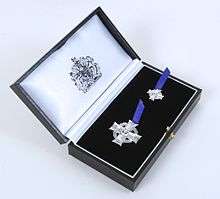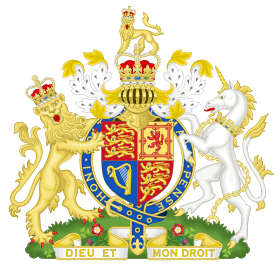Elizabeth Cross
The Elizabeth Cross is a commemorative emblem given to the recognised next of kin of members of the British Armed Forces killed in action or as a result of a terrorist attack after the Second World War.[1][2] It bears the name of the current British monarch, Queen Elizabeth II.
| Elizabeth Cross | |
|---|---|
 | |
| Awarded by the United Kingdom | |
| Type | Commemorative emblem |
| Eligibility | Member of the British Armed Forces killed in action or died of wounds caused by military actions |
| Awarded for | Granted to the next of kin of servicemen and women who died during operations or were killed as the result of terrorist action since the Second World War |
| Status | Currently awarded |
| Description | Cross made of hallmarked silver carrying the rose of England, the Scottish thistle, the Irish shamrock, and the Welsh daffodil. The centre bears the crowned cypher of Queen Elizabeth II. The cross is backed by a representation of a laurel wreath. |
| Statistics | |
| Established | 1 July 2009 |
| First awarded | 18 August 2009 |
| Posthumous awards | All awards are posthumous |
| Precedence | |
| Next (higher) | N/A |
| Equivalent | N/A |
| Next (lower) | N/A |

Appearance
Designed by Dayna White of Birmingham jewellers Gladman & Norman Ltd, the award is made of sterling silver in the shape of a cross backed by a representation of a laurel wreath, and carries floral emblems of England, Scotland, Ireland and Wales,[1][3] an appearance similar to the earlier Canadian Memorial Cross, awarded since 1919. The trial crosses, and the first few to be issued, were made by Gladman & Norman;[4] the company was awarded the long-term production contract in October 2009.[5] From May 2018 the contract to manufacture the cross passed to Worcestershire Medal Service.
Families receive a large version of the cross, and a pin-on miniature,[6] together with a Memorial Scroll signed by The Queen which bears the name of the person who died.[3]
The scroll bears the words:
This scroll commemorates [name] who gave his/her life for Queen and country on the [date] day of [month] [year]
The words were chosen by the previous Poet Laureate, Andrew Motion, and approved by the Chief of the Defence Staff Air Chief Marshal Sir Jock Stirrup and the three service chiefs.[6][7]
Institution and related awards
The award was instituted by Queen Elizabeth II on 1 July 2009, but eligibility is retrospective to deaths from the end of the Second World War.[3] Previously, for those who died in the First World War relatives were presented with a memorial scroll and bronze plaque, and for Second World War and Korean War deaths, relatives received a scroll.[1] The creation of the award was announced in a written statement to the House of Commons by Secretary of State for Defence Bob Ainsworth on 1 July, and also in a broadcast on the British Forces Broadcasting Service made by the Queen.[6][7] The idea for a new award was first approved on 10 June 2008, and it was expected that the details would be confirmed later that year.[8]
The formal Royal Warrant under the Royal Sign Manual establishing the Elizabeth Cross, dated 1 July 2009, was gazetted on 31 July 2009.[9] Among other things, the Royal Warrant states that relatives of members of the Royal Fleet Auxiliary will also be eligible to receive the award.
Award and eligibility
The first crosses were issued by the Ministry of Defence Medal Office at Imjin Barracks, Innsworth on 1 August 2009.[4][10]
Next of kin have the choice of a public presentation by the local Lord Lieutenant or a senior officer, or a private ceremony. Only the recognised next of kin receive the cross and miniature, but other relatives are able to request the issue of additional scrolls. Awards for those killed since 2000 are processed automatically by the Ministry of Defence, relatives of those killed earlier have to contact the MoD themselves. Relatives of those killed in Korea will already have received a scroll, so are presented with the cross only.[6][7]
The first public presentation of an Elizabeth Cross was on 18 August 2009 in a ceremony at Catterick Garrison. It was awarded to Karen Upton, the widow of Warrant Officer Sean Upton who was killed while on active service in Helmand Province, Afghanistan.[11] It was presented by the Lord Lieutenant of North Yorkshire, the Lord Crathorne, and the Master Gunner, St. James's Park, General Sir Timothy Granville-Chapman.[12]
The first presentations of the Elizabeth Cross to be made personally by Queen Elizabeth II took place on 12 September 2009.[13]
The precise eligibility requirements issued by the Ministry of Defence are:[14]
- Those who died from whatever cause whilst serving on a medal earning operation. Medal earning operations are those in which deployed personnel received a Campaign Medal, General Service Medal or Operational Service Medal which demonstrated the risk and rigour involved. Operations where a UN, NATO or other international body or other nations' campaign medal was accepted for wear, in the absence of a UK medal also qualify.
- Those who died as a result of an act of terrorism where the available evidence suggests that the Service person, whether on or off duty, was targeted because of his or her membership of the UK Armed Forces.
- Those who died on a non-medal earning operational task where death has been caused by the inherent high risk of the task.
- Those who died a subsequent and premature death as a result of an injury or illness attributed to the circumstances outlined above.
The service must have been undertaken on or after 1 January 1948 in general, or after 27 September 1945 in Palestine (other personnel from 1945–1947 were officially recognised as serving in the Second World War).[14]
In accordance with the Royal Warrant establishing the Elizabeth Cross, it is awarded upon recommendation made to the Queen by the Secretary of State for Defence. Thus, the judgement concerning the fulfilment of the eligibility requirements in any particular case is made by the Ministry of Defence, and the formal award of the Elizabeth Cross is ordered by the Queen upon the advice of the Defence Secretary. As directed by the Royal Warrant, the names of all those who are commemorated with the award of the Elizabeth Cross are recorded in a Registry kept by the Ministry of Defence.
Also in accordance with the Royal Warrant that established the Elizabeth Cross, the Cross and its miniature version may be worn by the recipient (i.e., the deceased's designated next of kin) at that person's discretion. In 2010, regulations were approved by the Queen dealing with the scenario of the designated next of kin of the deceased being himself or herself a member of the Armed Forces, and therefore making provision for the use of the Elizabeth Cross in military uniform. Under those regulations, the Elizabeth Cross can be worn on the right side of uniforms whenever other medals are worn if the recipient so chooses.
The Ulster Defence Regiment CGC
Successful applications
Up to May 2010, 232 Elizabeth Crosses and Memorial Scrolls have been issued to the families of The Ulster Defence Regiment CGC personnel whose deaths are officially attributed to their military service.[15]
Failed applications
Up to November 2010, 37 applications linked to The Ulster Defence Regiment CGC for the Elizabeth Cross have failed due to the following reasons:[16]
- 22 died of natural causes whilst off duty
- 7 were killed in road accidents whilst off duty
- 4 were accidental deaths whilst off duty
- 2 died outside the Northern Ireland operational area
- 2 died after they were discharged from service.
New Zealand Memorial Cross
Since the Second World War New Zealand has similarly issued a cross to the relatives of those killed on active service. The New Zealand Memorial Cross was recently awarded to the family of the late Lt. Tim O'Donnell DSD as well as other soldiers' families who had served in Afghanistan.[17][18][19]
References
- "Elizabeth Cross Honours Families of Fallen Troops". Ministry of Defence. 1 July 2009. Archived from the original on 4 July 2009. Retrieved 1 July 2009.
- "Bereaved Service families to be awarded Elizabeth Cross". Daily Telegraph. 1 July 2009.
- "New Queen's award for forces dead". BBC. 1 July 2009. Retrieved 1 July 2009.
- "Birmingham medal company fights for MoD contract to produce the Elizabeth Cross". Birmingham Post. 30 July 2009.
- "Elizabeth Cross medal to be made in Birmingham". Birmingham Mail. 24 October 2009. Retrieved 2 November 2009.
- Michael Evans (1 July 2009). "Grieving Forces' families to get new Elizabeth Cross military award". The Times. London. Retrieved 1 July 2009.
- "Queen honours dead service personnel with award—The Queen will recognise the loss suffered by the families of armed forces personnel killed on operations with the award of an Elizabeth Cross, it has been announced". The Daily Telegraph. London. 1 July 2009. Retrieved 1 July 2009.
- "New Award for families who have lost Service Personnel". Ministry of Defence. 10 June 2008. Archived from the original on 15 July 2009. Retrieved 1 July 2009.
- "No. 59144". The London Gazette. 31 July 2009. pp. 13209–13210.
- "Elizabeth Cross awards to be handed out". Gloucestershire Echo. Northcliffe Media. 1 August 2009. Archived from the original on 6 August 2009. Retrieved 6 August 2009.
- "Widow gets first Elizabeth Cross". BBC. 18 August 2008. Retrieved 18 August 2009.
- "First Elizabeth Cross presented to family of fallen soldier". Ministry of Defence. 19 August 2009. Archived from the original on 22 August 2009. Retrieved 2 September 2009.
- "Queen honours regiment's fallen". BBC. 12 September 2009. Retrieved 14 September 2009.
- "The Elizabeth Cross – Died on Operations Recognition Award". Ministry of Defence Medal Office. 1 July 2009. Retrieved 1 July 2009.
- Response to a request made under the Freedom of Information Act 2000 Whatdotheyknow.com
- Response to a request made under the Freedom of Information Act 2000 Whatdotheyknow
- Other distinctive New Zealand honours DPMC
- Medals NZDF
- NZDF Medals NZDF
